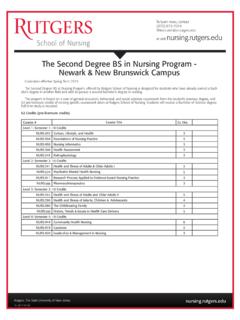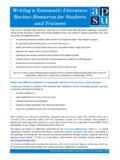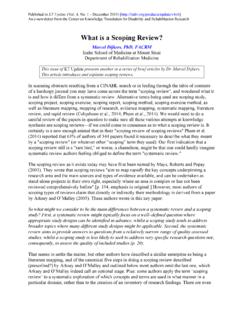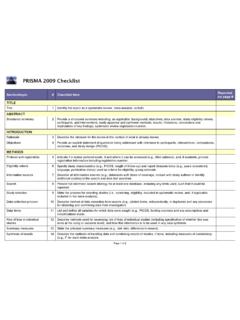Transcription of Appendix 5 Systematic Review Proposal Outline
1 Appendix 5 Systematic Review Proposal Outline Developing a Protocol for a Systematic Review Using the Joanna Briggs Institute (JBI) Method The New Jersey Centre for Evidenced Based Healthcare and Patient-Outcomes Research Rutgers, The State University of New Jersey, School of Nursing Important Points 1. A Systematic Review Proposal serves as a map for the Review . Transparency is important. The objective in writing a Proposal for a Systematic Review is to clearly and succinctly describe what you want to do, why it is important that the Review be done, what methods will be used to conduct the Review and how the findings of the Review might be utilized. 2. The Review must be written in English (AU) and in Vancouver format. This guideline is written in English (AU). 3. The body of the Proposal for a Systematic Review should abut 10-15 pages of single spaced text. 4. If the Review is undertaken as a doctoral study project, at least one of the reviewers must be a faculty member, and the faculty member must be trained in the JBI method of Systematic Review .
2 5. If the Review is other than a doctoral study project, either the primary or secondary reviewer must be trained in the JBI method of Systematic Review . 6. Expect to spend at least 8-12 months completing the Review . 7. Use of the CReMS Proposal development software provides pre-specified language with a fill in the blanks option to customize the Review . 8. Always read one or two proposals on the JBI website before starting to write your own to get a feel for the flow and wording of the JBI method. Page 1 of 10 The key components of a Systematic Review Proposal are: 1. Title 2. Reviewers 3. Beginning and Ending Dates 4. Objective 5. Background 6. Criteria for inclusion of studies in the Review Types of Studies Types of Intervention/Phenomenon of Interest Types of Outcomes 7. Search Strategy 8. Assessment of Methodological Quality Critical Appraisal 9. Method to Extract Data 10. Method to Synthesize Data 11. References and Appendices Any acknowledgements should be listed at the end of the paper Page 2 of 10 Title of Systematic Review Protocol The title of the protocol should precisely describe the Review to be undertaken.
3 It should not be more than ten-twenty words. One simple sentence that includes the aims and outcomes of the study should suffice. The formal title of the Review should be written after the aims and objectives of the Review are finalized to ensure congruency. To be a comprehensive Review , the Review must consider both qualitative and quantitative evidence. Title examples: A Systematic Review of the effectiveness of smoking cessation strategies for adolescents in a residential facility: Systematic Review protocol A qualitative Systematic Review of the experiences of families of patients in an intensive care unit A comparison of the cost effectiveness of three different methods of intravenous dressing change Reviewers At a minimum, a primary and secondary reviewer should be identified. At least one of the reviewers must be trained in the JBI method of Systematic Review . Reviewers work independently of each other. The primary reviewer is responsible for the overall conduct of the Review and for keeping reviewers on track and moving toward completion of the Review .
4 Both reviewers should have a good understanding of research design and the ability to critique research studies. Identifying a third reviewer at the beginning of the Review in the event there is disagreement between the primary and secondary reviewer. The third reviewer will assist in resolving any differences. If the Review is a doctoral study project, the faculty member will resolve any differences. Page 3 of 10 Beginning and Ending Dates An attempt should be made to identify the dates when the Review will begin and the anticipated date of completion. Determining these dates before the Review begins can assist in keeping the project on track. Most reviews require 8-12 months for completion. Background The background should describe the issue under Review in sufficient detail so that the necessity for conducting the Review is clear and unambiguous. It should lay a broad base for the issue that led to the Review . A description of the target population, the interventions or phenomenon to be reviewed, and the potential uses of the findings should be presented.
5 Use of statistics can aid in understanding the significance of the Review . The background should indicate why the Review is necessary and its contribution to health care. The background provides the foundation for development of the Review objectives and aims. Questions that need to be addressed in the background include: Who will benefit? What are the specific issues to be addressed? What is the target population? What is the context of the investigation? Why is it necessary to Review and pool studies on this topic? Why is this work important? What has already been published? How will this build on published literature , inform practice, and/ or formulate policy? Objectives The Review objectives are grounded in the Review question and provide the basis for development of the inclusion criteria. The rationale for the objectives should be found in the Page 4 of 10 background. Review objectives are written in measurable terms and need to address the target population, intervention or phenomenon and outcomes.
6 An overall objective for the Review is provided first, followed by sub-objectives, as appropriate. Some questions to ask as the Proposal objectives are written: Does the overall objective clearly describe the Review s purpose and direction? Are the objectives realistic and feasible in relation to the completion date selected? Do the objectives match what is described in the background? Are the objectives stated in measurable terms? Are there objectives written that describe the anticipated outcomes of the Review ? Criteria for Inclusion of Studies in the Review Inclusion criteria Systematic reviews are distinguished by the transparency with which they are conducted. One of the features that allow this transparency is the pre-specification of the Review s inclusion and exclusion criteria, that is, those criteria that make a study eligible for inclusion in the Review . Eligibility criteria include parts of the Review question and the types of studies that will be sought.
7 The types of participants, types of interventions or phenomenon of interest, and the types of outcomes expected are addressed in the eligibility criteria for the Review . Types of studies This section describes the type of studies that will be considered for Review . Always start this section by saying: The Systematic Review will consider randomized controlled trials that OR This Systematic Review will consider studies using a qualitative design, such as phenomenology, grounded theory, narrative In those instances where the reviewer Page 5 of 10 believes that it might be difficult to find the preferred study, the type of study or other literature that will be used instead should also be described. For example: In the absence of randomized controlled trials, descriptive studies such as .. Types of Participants Participants in a Systematic Review refer to the subjects used in the primary studies that will be included in the Review . Criteria for selection of these participants must be very clear and specific as key words for searching are developed using these criteria.
8 Participants should be defined in three ways. First, the disease or condition of interest, such as urinary tract infection, breast cancer or type 2 diabetes should be specified. Second, the population of interest must be described in as few words as possible. This step involves deciding on the characteristics or attributes of the population, such as age, race, ethnicity, and educational level. Finally, the type of setting, such as acute care hospital, community mental health center, and ambulatory surgery is described. For example, in a study of the effectiveness of warming methods on operative hypothermia: Adults 18 years of age, who underwent any type of surgery will be included. Patients who were subject to deliberate hypothermia such as those for cardiac or neurosurgical interventions were excluded. In this example, the condition of interest is hypothermia, the population of interest is any adult aged 18 years or older, and the setting of interest is surgery. Types of Interventions/Phenomenon of Interest Next, a description of the types of interventions or phenomenon of interest is necessary.
9 If the Proposal is for a Review of interventions, the primary and comparison interventions need to be fully described. Following a description of the primary intervention of interest, a decision needs to be made regarding the comparisons, for example, a placebo, another intervention, nothing or Page 6 of 10 usual care. Observational Systematic reviews (such as those about risk factors) and qualitative reviews do not have a comparator. Types of Outcomes Explicit criteria for establishing the presence of appropriate outcomes and if necessary, their combinations must be specified. The background should provide enough information to justify the outcomes included and potentially those that were not included. Each outcome should be described and the way in which it was measured should be provided. For example: Length of stay, which will be inclusive of day of admission to day of discharge, will be measured in days. Search strategy for identification of studies The search for articles and papers to be included in the Review can be compared to enrolling patients into a primary research study.
10 The articles selected as a result of the search process are, in essence, the subjects for the Review . Keywords and phrases provide the foundation for searching, and are derived from the Review question. The search includes both published and unpublished work. A concept map is useful in expanding on key words. For example, the phrase critical care can be mapped to include intensive care, intensive care unit, critical care unit, or ICU as well as identified by specialty area, for example, coronary care unit, pediatric intensive care unit, and surgical intensive care unit. By mapping each of the key words and phrases, a more comprehensive search can be conducted. The phases of the search strategy should be very detailed including the initial search and the subsequent expanded search. The search should be described in stages. Stage 1 is the first attempt at the search in which the reviewers use a limited set of key words to find potentially relevant studies. These Page 7 of 10 studies are reviewed in an effort to expand key words and phrases for a more in-depth search.












